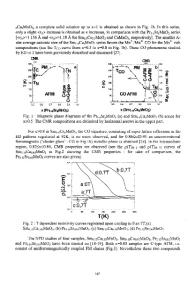Structural and Magnetic States in Layered Manganites: An Expanding View of the Phase Diagram
- PDF / 4,108,934 Bytes
- 12 Pages / 414 x 635.4 pts Page_size
- 120 Downloads / 304 Views
ABSTRACT Colossal magnetoresistive (CMR) manganites display a spectacular range of structural, magnetic, and electronic phases as a function of hole concentration, temperature, magnetic field, etc. Although the bulk of research has concentrated on the 3-D perovskite manganites, the ability to study anisotropic magnetic and electronic interactions made available in reduced dimensions has accelerated interest in the layered Ruddlesden-Popper (R-P) phases of the manganite class. The quest for understanding the coupling among lattice, spin, and electronic degrees of freedom (and dimensionality) is driven by the availability of high quality materials. In this talk, we will present recent results on synthesis and magnetic properties of layered manganites from the La 2.21 Sr1 +2xMn 20 7 series in the Mn4+-rich regime x > 0.5. This region of the composition diagram is populated by antiferromagnetic structures that evolve from the A-type layered order to G-type "rocksalt" order as x increases. Between these two regimes is a wide region (0.7 < x < 0.9) where an incommensurate magnetic structure is observed. The IC structure joins spin canting and phase separation as a mode for mixed-valent manganites to accommodate FM/AF competition. Transport in these materials is dominated by highly insulating behavior, although a region close to x = 0.5 exhibits metal-nonmetal transitions and an extreme sensitivity to oxygen content. We suggest two possible explanations for this transport behavior at doping just above x=0.5: localization by oxygen defects or charge ordering of Mn 3 /Mn4 sites.
INTRODUCTION Colossal magnetoresistive oxides have captured the interest of condensed matter scientists because of their strong coupling among spin, lattice, and charge degrees of freedom. The delicate balance of energy scales among these three aspects of manganite physics gives rise to the dramatic properties observed in the manganites, including insulator-metal (IM) transitions,
.11.. Figure 1. 315 Mat. Res. Soc. Symp. Proc. Vol. 602 © 2000 Materials Research Society
competing ferromagnetism (FM) and antiferromagnetism (AF), polaron dynamics, Jahn-Teller distortions, etc. To date, there are three classes of oxide materials that exhibit colossal magnetoresistance; these three structure types are pictured in Fig. 1. On the left is the well-known perovskite phase, on the right is the pyrochlore structure of T12Mn2O7, and in the middle is the layered n=2 Ruddlesden-Popper (R-P) phase. All three structure types have corner-linked MnO6 octahedra as their building blocks, although the connectivity of these octahedra is somewhat different in the pyrochlore. It is generally accepted that the mechanism of CMR in the pyrochlore differs from that of the perovskite or layered compounds, as the pyrochlore is not a mixed-valent compound like the other two materials. Although much of the focus in manganite research has centered around the perovskites, the discovery by Moritomo, et al.[1] of dramatically higher low-field magnetoresistance in the layered mangan
Data Loading...











